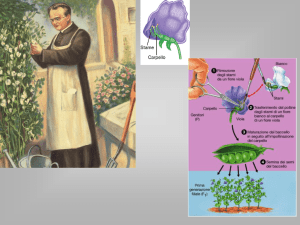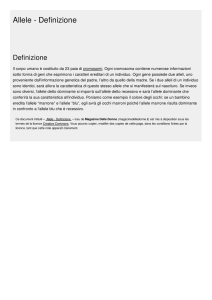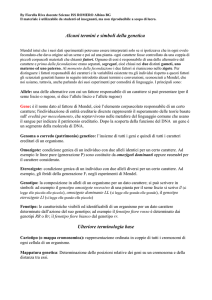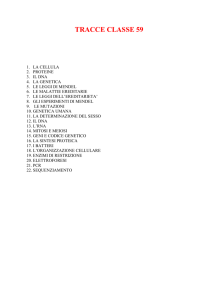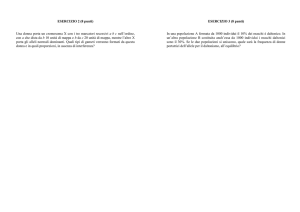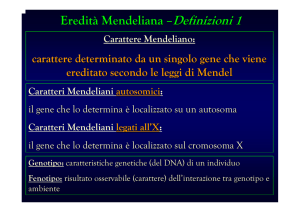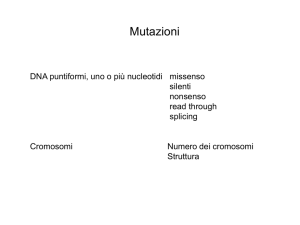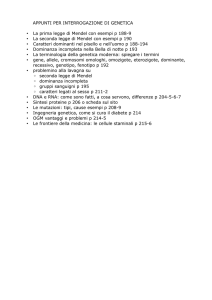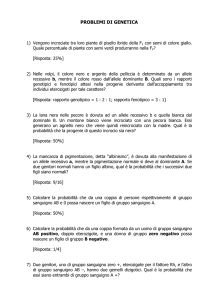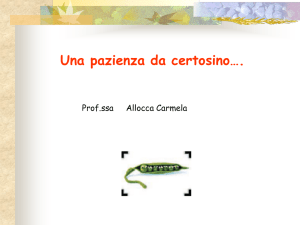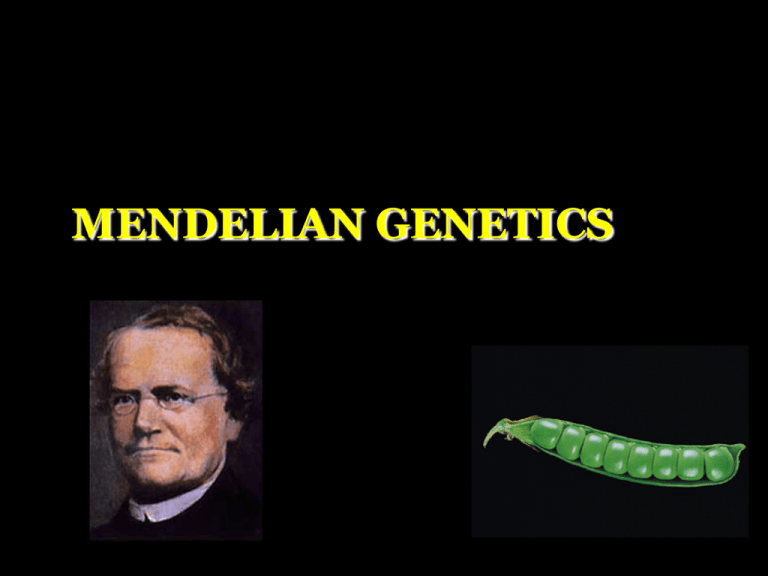
MENDELIAN GENETICS
Genotype
Acytivity
of other genes
Environment
Phenotype
Pisum sativum
Allele R
Allele r
Organism (Pisum Sativum)
Stamen (male reproductive organ) m
Pistil (female reproductive organ) f
Autofecondation
↓
Stamen produces pollen
↓
deposed on pistil
(fecundation)
Anther
Stigma
Stylus
Ovary
Terminology
Gametes = a mature reproductive cell specialized
for sexual fusion. A gamete is haploid and fuses
to a gamete of the other sex.
Cross = mating of two individuals with fusion of
gametes
Zygote = cell resulting from the fusion of two
gametes
Parental generation = P
First generation = F1
Second generation = F2
Crossing F2 x F2 = F3
F3 x F3 = F4 and so on
Crossing F2 x F1 = backcross
Mendel initially crossed pure lines differing for a
single trait (monohibrids)
Es. P = smooth (m) x rough (f)
F1 = smooth
Reciprocal cross
P = Smooth (f) x rough (m)
F1 = smooth
Interpretation:
The F1 trait was identical to the one of the two P,
and NOT a mizture of the two.
Principle of F1 uniformity
F1 x F1
↓
F2 (smooth and rough, 3:1 ratio)
Same resulta with ALL other 6 traits considered
Mendel concluded the principle of
DOMINANCE:
Crosses of plants differing in a single
trait with two phenotypes result in
hybrids in which only one phenotype,
termed dominant, is manifest.
The data
General conclusions
1) Risults of crosses very similar
2) F1 always similar to one of the parental lines
3) F2 show the trait “disappeared” in F1
Mendel concluded that alternative phenotypes
were due to “factors” (which now call genes)
Mendel hypothesized that such factors would exist
in alternative forms (alleles) each controlling a
character carattere (smooth or rough etch)
Mendel also hypothesized that:
1) Every parental pure line (P) has two characters
2) Since F2 shows both, F1 must have the one on
display and the one not shown.
The allele masking one of the character in F1 is
termed dominant.
The allele masked in F1 is termed recessive.
Individual with the SAME couple of alleles are
called homozygotes
Individuals with different alleles are called
heterozygotes
Dominant traits are on display in homozygosity and
heterozygosity
Recessive traits are on display only in
homozygotes.
First principle of Mendel
Principle of segregation:
Each diployd individual has 2 alleles segregating
during gametes formation, each with an allele.
The principle of dominance establishes that when two
alleles are present, only the dominant allele is manifest
in the phenotype.
Albinism= recessive aa
Normal phenotype= AA o Aa
1. What is the probabilities that normal heterozygous
individuals generate an albino son/daughter?
2. Three albinos?
3. One albino and two with a normal phenotype?
DIHYBRIDS CROSS
Mendel crossed pure lines with two distinct phenotypic traits
He showed that the segregation of one trait does not depent
upon the presence of the other: second principle of
independent segregation.
We now know that genes positioned on different
chromosomes behave independently upon the individual
segregation of the chromosome in gametes.
Second PRINCIPLE 0f Mendel
Independent segregation of traits:
The “factors” controlling different traits are
distributed in an independent way one from the others.
Test cross
Crosses with pure lines of three traits
Number of
Alleles couples
(traits)
1
2
3
4
n
Number of
phenotypic classes
2
4
8
16
2n
Number of
genotypic classes
3
9
27
81
3n
Seed smooth-yellow X Seed rough-green
Ss Yy
ss yy
2
=∑
Χ
df= n-1
2
(o-a)
a
Dominant hereditary diseases:
Brachydactily
Recessive hereditary diseases
Mutations inducing a loss-of-function.
Heterozygous (carriers) are normal, una riduzione
del prodotto proteico del 50% viene tollerato se il
rimanente 50% è sufficiente per una funzione normale
Sickle Cell anemia
1. INCOMPLETE
DOMINANCE
The phenotype of
heterozygotes is
intermediate between
homozygotes
2. CODOMINANCE
The heterozygote shows the phenotypes of both
homozygotes (dominant and recessive)
Blood groups
Phenotype
0
A
B
AB
Genotipo
i/i
IA/IA o IA/i
IB/IB o IB/i
IA/IB
3 allelic variants:
IA; IB (dominant);
i (recessive)
Il locus ABO codifica per la glicosiltransferasi
Fenotipo
M
N
MN
Genotipo
LM /LM
LN/LN
LM/LN
Due varianti alleliche:
LM ; LN (codominanti)
Fenotipo
Rh+
Rh-
Genotipo
Fattore Rh
Nel 1940 è stato scoperto da Landsteiner e Wiener
un nuovo antigene eritrocitario chiamato “D” che è
stato denominato fattore Rh. In seguito sono stati
scoperti altri antigeni denominati C (C grande), c (c
piccolo), E (E grande), e (e piccolo) che insieme
all’antigene D (D grande) formano il sistema Rh.
L’antigene più importante è il D che è presente in
circa l’85% dei soggetti. Non è stato trovato
l’antigene d (d piccolo), per cui i soggetti che
presentano il D sono definiti Rh + (Rh
positivi), soggetti che non presentano
l’antigene D sono definiti Rh - (Rh negativi).
D /D o D/d
d/d
Due varianti alleliche:
D ; d (dominanti)
Eritroblastosi fetale
Padre Rh+
DD
Madre Rhdd
Figlio Rh+
Dd
Produzione anticorpi contro D
Possibile anemia del figlio
Interactions between genes
Epistasis:
Form of interaction between genes,
in which the activity of one gene
masks the phenotypic contribution
of a second gene.
The 9:3:3:1 ratio is modified in a
dyhybrid cross
The gene masking the expression of
the second gene is called epistatic,
the masked gene ipostatic.
C controlla la formazione del
colore del pelo
C/ -neri
c/c albini
A determina l’aspetto aguti
A/- aguti
a/a non aguti
Fenotipi: A/- C/- aguti
a/a C/- neri
A/- c/c oppure a/a c/c albini
9
3
3+1
DOMINANT EPISTASIS
Colore del frutto in varietà di zucca:
allele W impedisce la colorazione
allele w non interferisce con la colorazione
allele Y colore giallo
allele y colore verde
F2:
P: zucche bianche X zucche verdi
F1: 100% zucche bianche (W/w Y/y)
W/w Y/y X W/w Y/y
3/4 W/-
1/4 w/w
3/4 Y/-
9/16 W/- Y/-
9/16
bianco
1/4 y/y
3/16 W/- y/y
3/16 bianco
3/4 Y/-
3/16 w/w Y/-
3/16 giallo
1/4 y/y
1/16 w/w y/y
1/16 verde
12/16
Espressione genica ed ambiente
Penetranza ed espressività
Non tutti gli individui con un particolare genotipo manifestano il
fenotipo atteso.
La frequenza con cui un gene dominante o omozigote recessivo
si manifesta in una popolazione si definisce PENETRANZA.
L’espressività è il grado in cui un gene o un genotipo penetrante
è espresso fenotipicamente in un individuo.
Polidattilia umana (dita mani e piedi in soprannumero)
Autosomica dominante
90% Penetranza
Es: 42 individui con allele polidattilia di cui solo 38 sono
polidattili
38/42= 0.90= 90%
Neurofibromatosi
Autosomica dominante
Penetranza 50-80%
Espressività variabile
Effetto dell’ambiente
Età insorgenza (?)
Cambiamenti ambiente interno che possono influenzare funzione
genica.
Es:
Calvizie compare nei maschi tra 20 e 30 anni
Distrofia muscolare di Duchenne nei bambini tra 2 e 5 anni
Sesso
Espressione genica influenzata dal sesso.
Geni autosomici controllano caratteri che si manifestano solo in
un sesso. Caratteri limitati al sesso:
Es:
Uomo: distribuzione peli del viso
Pecore: comparsa delle corna nei maschi
Caratteri influenzati dal sesso:
Si manifestano in entrambi i sessi con diversa frequenza di
comparsa.
Es:
Calvizie controllato da gene autosomico dominante
nell’uomo e recessivo nelle donne.
L’allele b è influenzato
dagli ormoni con
espressività variabile.
Es:
Gotta - Maschi:femmine= 8:1
Artride reumatoide - Maschi:femmine= 1:3
Osteoporosi - Maschi:femmine= 1:3
Temperatura
Enzimi temperatura sensibili
Es:
colore del pelo conigli razza himalayana
Sostanze chimiche
Alcune sostanze chimiche hanno effetti significativi
sull’organismo
Es:
Fenilchetonuria (PKU): autosomica recessiva, difetto
via biochimica del metabolismo della fenilalanina
Omozigoti manifestano diversi sintomi (ritardo mentale in età
precoce) e la gravità dipende dalla dieta. Limitazione della
quantità di fenilalanina nella dieta
Fenilalanina
idrossilasi
Ritardo mentale;
crescita ridotta;
morte prematura
I caratteri legati al sesso
Aplodiploidia
Ereditarietà concatenata al sesso
Occhi rossi Occhi bianchi
Occhi bianchi Occhi rossi
X
X
F1
F2
Occhi rossi 100%
F1
100% Occhi rossi
100% Occhi bianchi
100% Occhi rossi
50% Occhi rossi
50% Occhi bianchi
F2
50% Occhi rossi
50% Occhi bianchi
50% Occhi rossi
50% Occhi bianchi
Turner Syndrome (X0): 99% XO embryos die
1% show defects at puberty
frequency1/10000 newborns
Klinefelter syndrome (XXY): Frequency 1/1000 newborns
XXX: normal females, less fertili, lower IQ
XYY: male taller, rarely sterile
X0: sterile female
XXY: sterile male
Hemophilia A: X-linked recessive
Enamel hypoplasia: X-linked dominant

